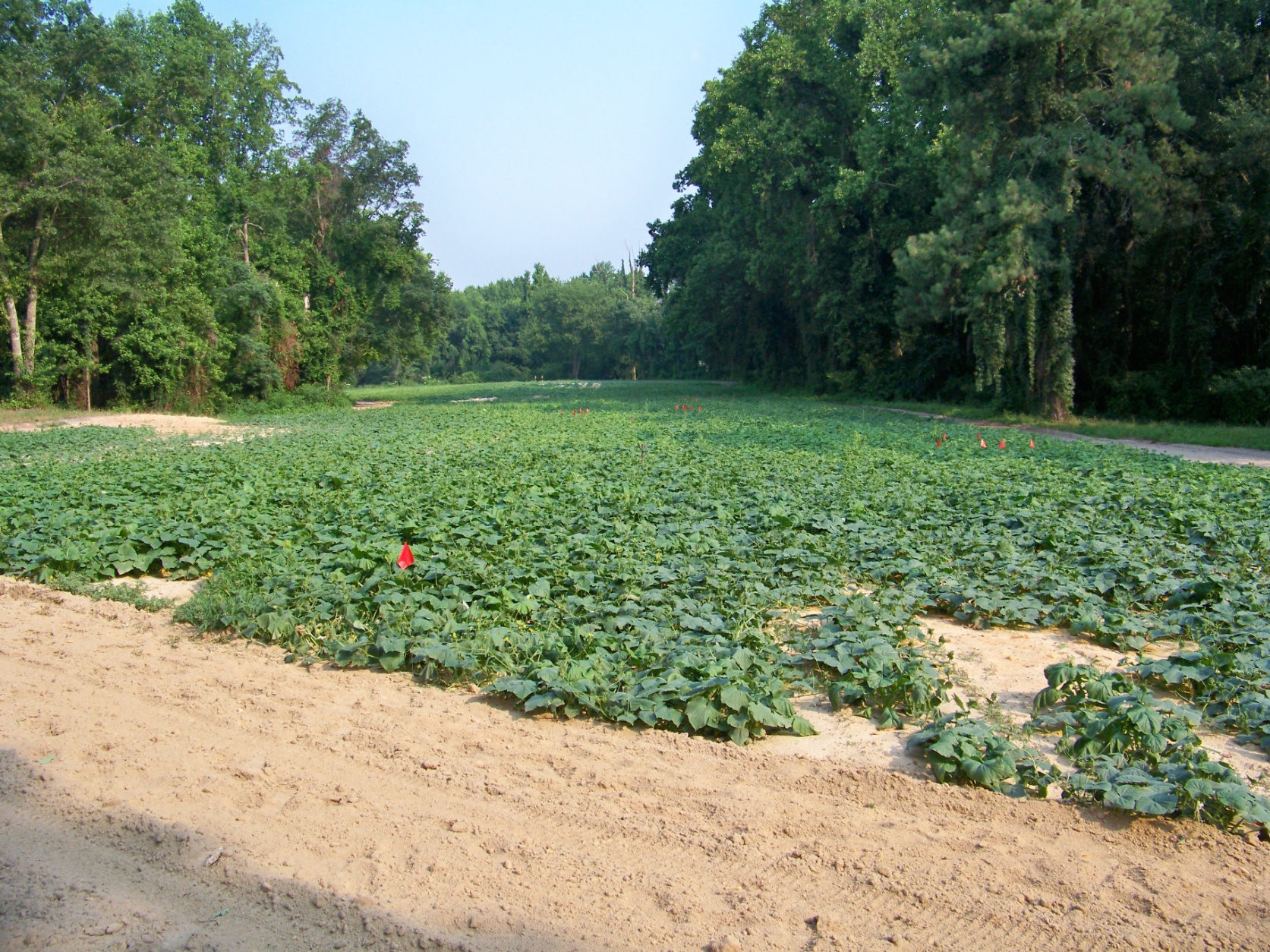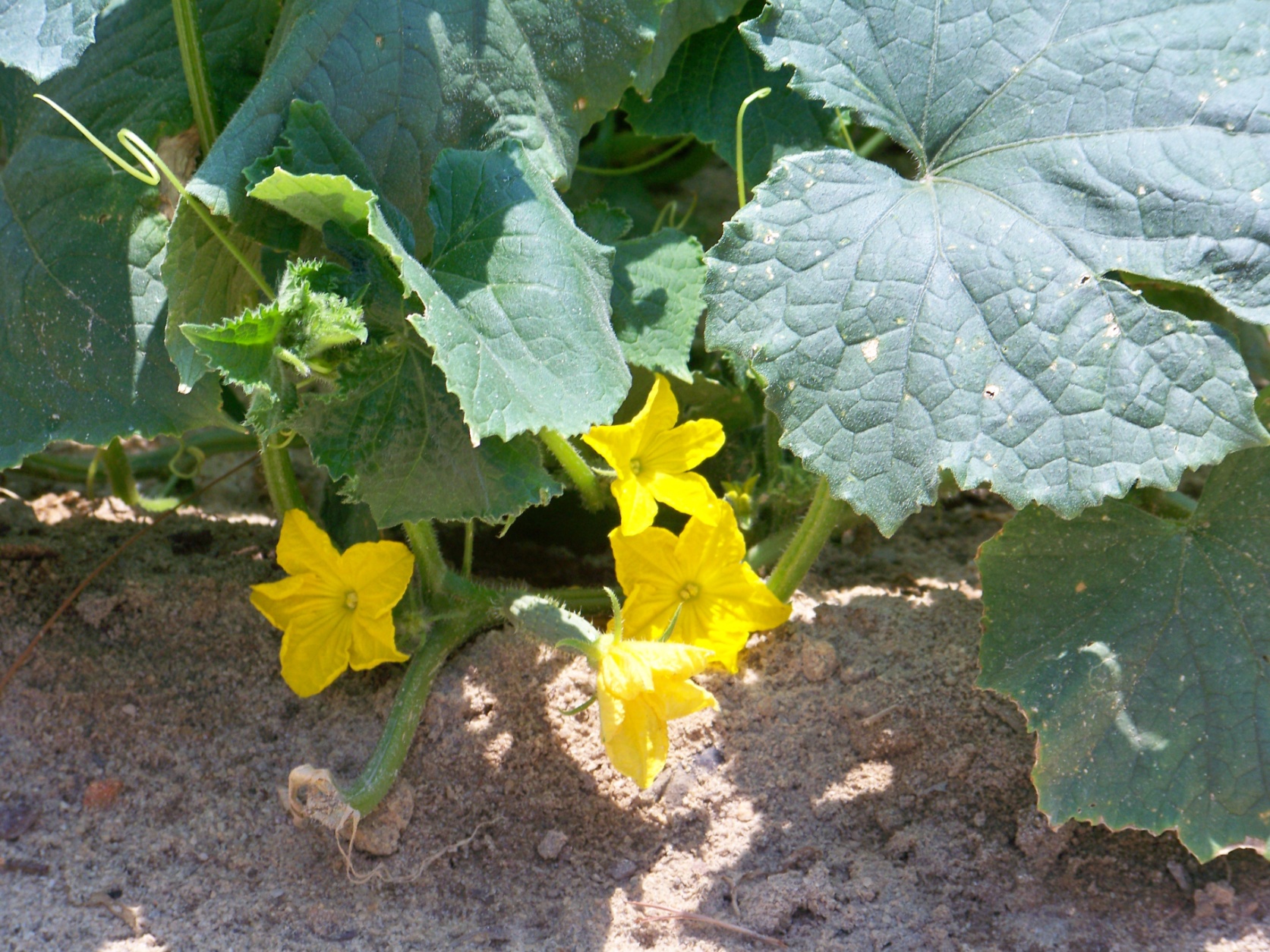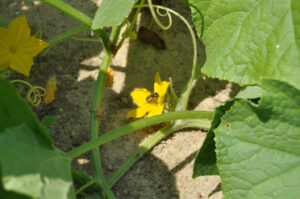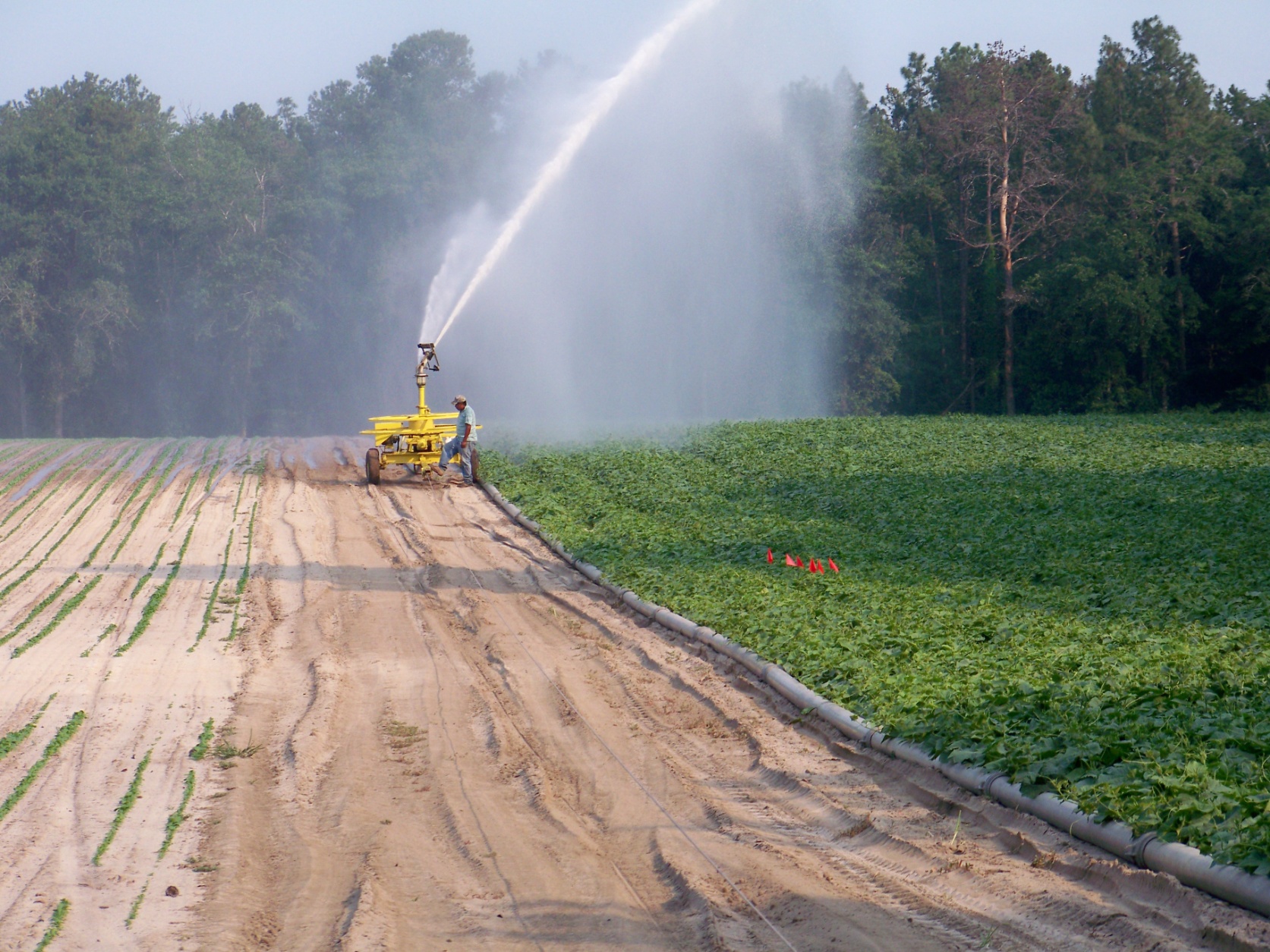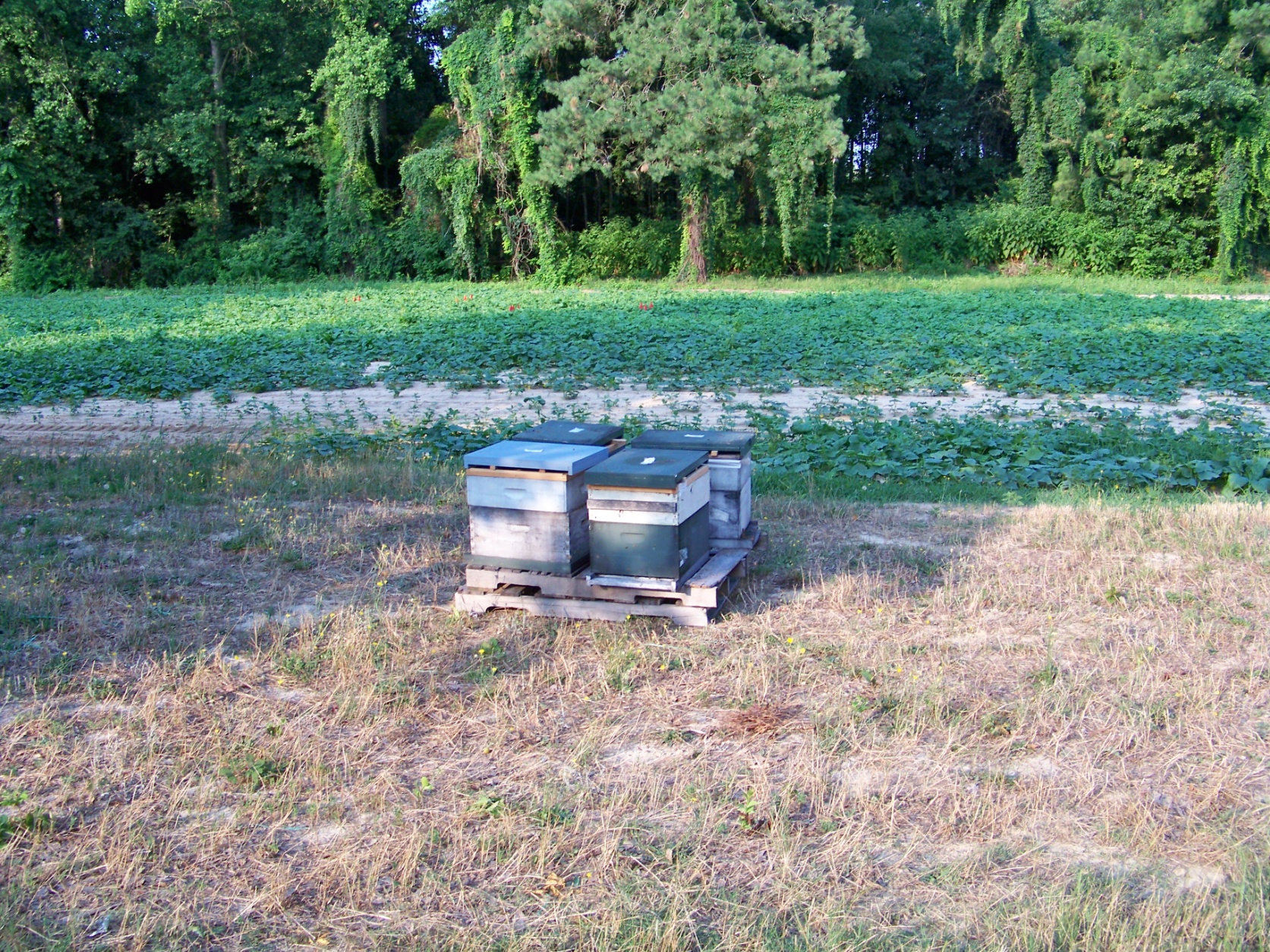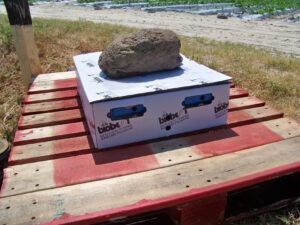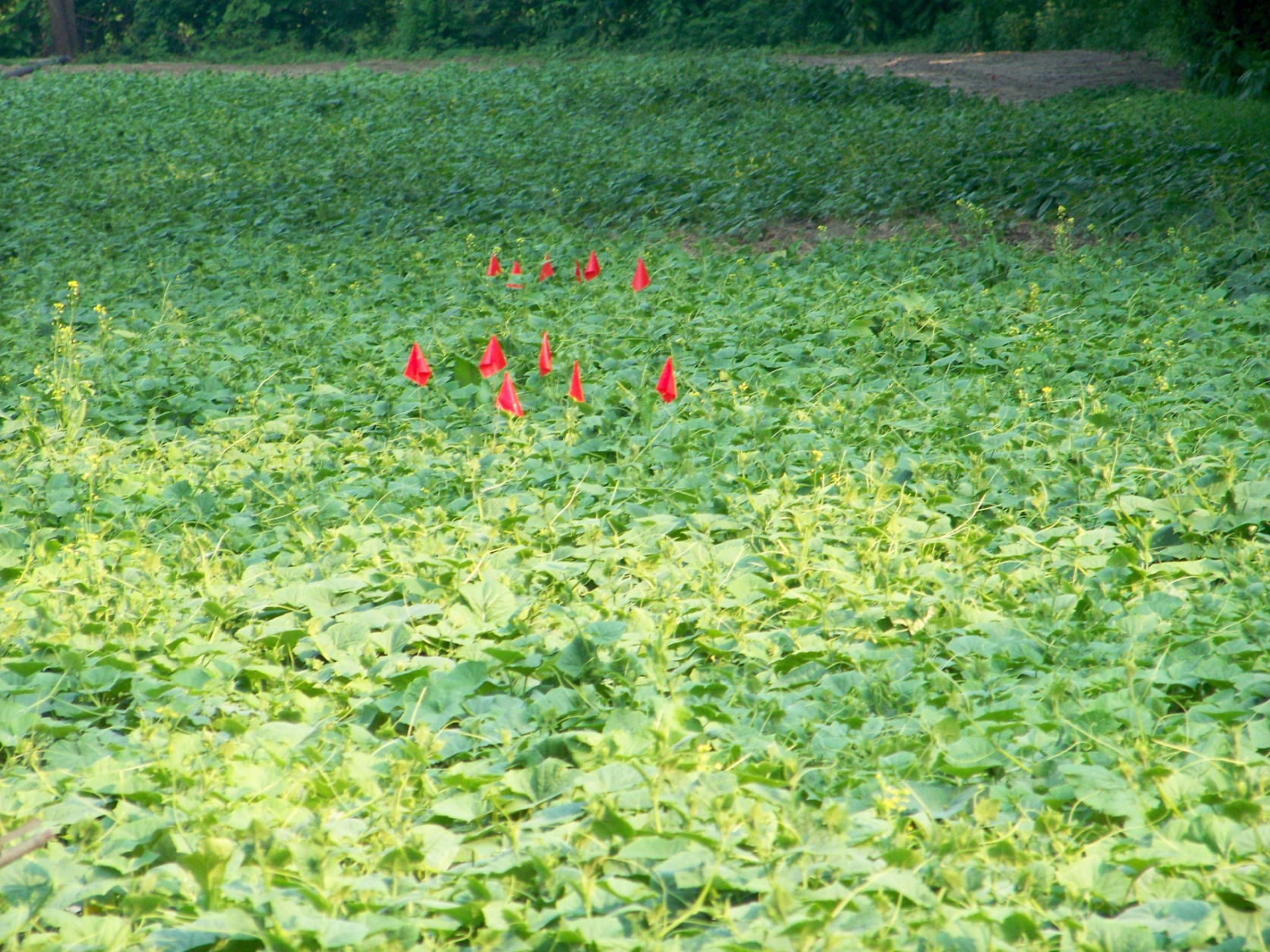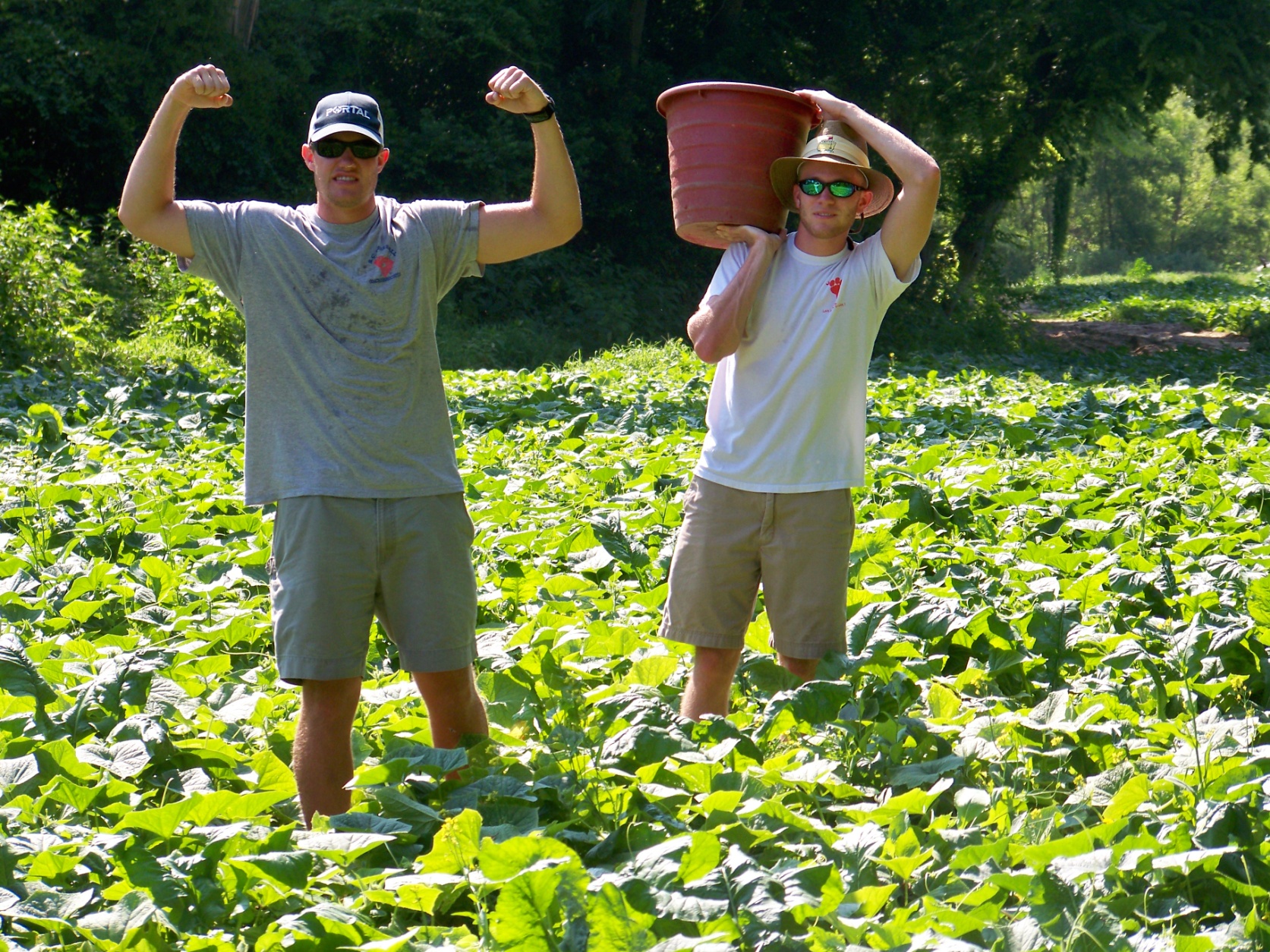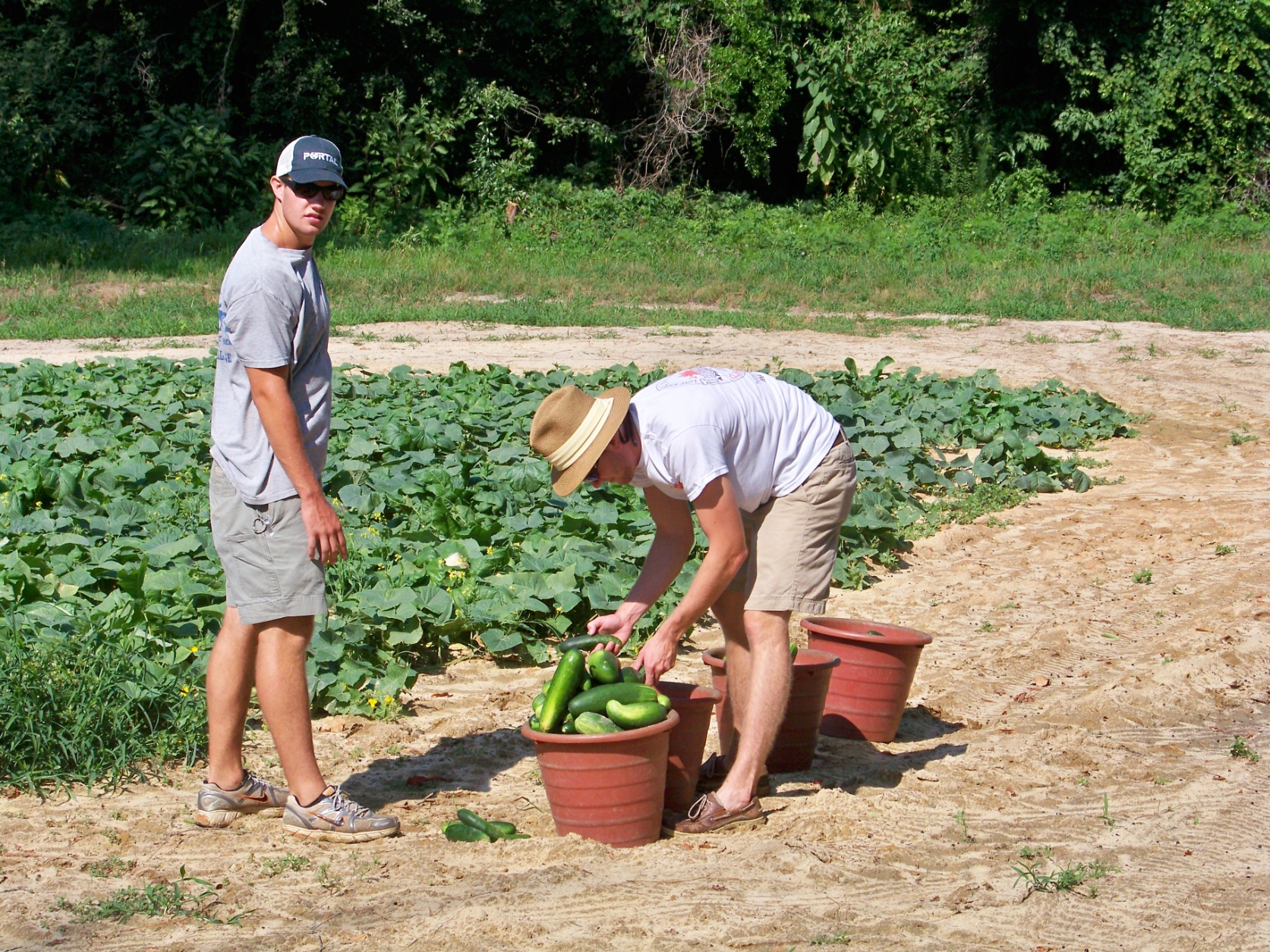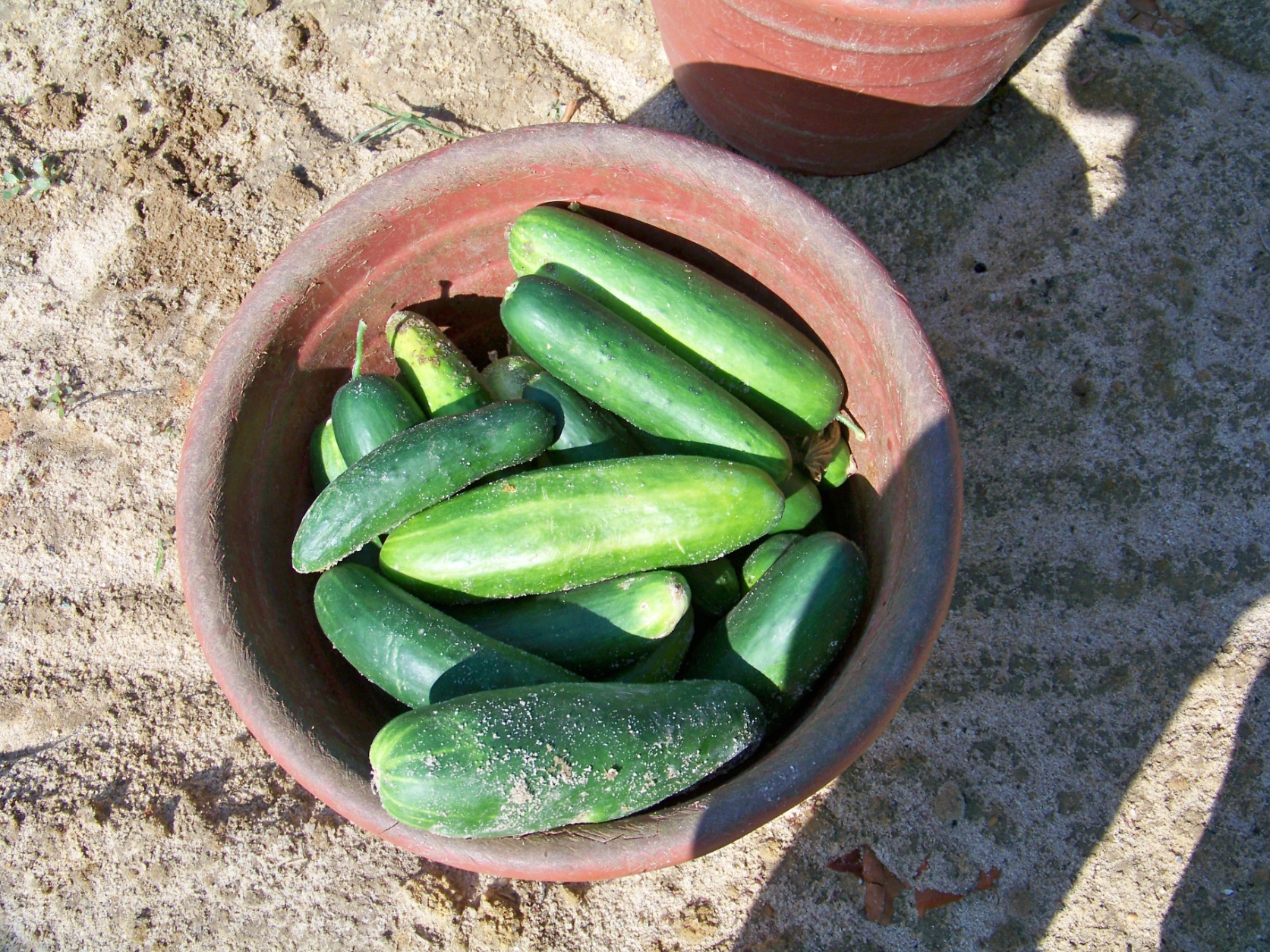2011 Annual Report for FS11-255
Cucumber Pollination with Bumblebees
Summary
Wild pollinator numbers have diminished over the last 30 or so years in the Lexington, SC area and worldwide. Farmers previously relied on wild pollinators to provide a substantial amount of pollination for their crops. Honey bees have in recent years been used to pollinate crops such as squash, cucumbers, and melons due to the large number of bees per hive. Honey bee colonies may have 30,000 honey bees whereas a bumble bee nest may have only 300 bumble bees. However, honey bees do not fly in inclement weather that includes lower temperatures and wind (1). Honey bees also tend to go down rows whereas bumble bees tend to go across rows or are more erratic in their foraging (1). Farmers are becoming more interested in having alternative pollinators to ensure proper pollination for their crops.
Two, two acre cucumber fields (Cucumis sativus) were planted the first week of May, 2011. We planted the two fields as far apart as we could but this still resulted in the fields being 1.5 miles of each other on this farm. Honey bees typically travel a 2-3 mile area and bumble bees forage in a ¼ to ½ mile range. We were concerned about the honey bee isolation of the bumble bee field and found there were other beekeepers with honey bee colonies within 2-3 miles of the bumble bee field. In addition, we had eight honey bee colonies about 1.5 miles in another field for pollination of other crops. However, this was as far apart the fields could be planted for isolation as possible on this grower’s farm.
The main honeybee nectar / honey flow was over for approximately two weeks prior to the onset of cucumber blooming. There is typically a honey bee nectar dearth beginning mid June in the Lexington, SC area with the cucumbers, in this case, being one of the few nectar sources available. Hence, we had excellent honey bee pollination of the cucumber fields; the cucumbers were one of the main plants blooming in the area.
The bee counts are included in the attached excel spreadsheet and show (using an Excel dual t test) the honey bee visits between the fields are not statistically independent (?=0.05 level). The number of bumble bee visits was insignificant and did not meet the following table bee visit requirements.
The following table is consulted (2) to determine adequate bloom bee visits for cucumbers (need 10-15 visits per bloom per day min):
| Time of count Min | # bees/30 flowers/30 minutes |
| 8:00-9:00 | 1 |
| 9:00-10:00 | 3 |
| 10:00-11:00 | 9 |
| 11:00-12:00 | 13 |
| 12:00-1:00 | 16 |
| 1:00-2:00 | 13 |
| 2:00-3:00 | 11 |
| 3:00-4:00 | 7 |
| 4:00-5:00 | 5 |
Table 1: adequate bloom bee visits for cucumbers
If it was not for the honey bee visits and extraneous other pollinators, the cucumber crop in the bumble bee field would have had insufficient pollination due to the extremely low number of bumble bee visits. There was an increase in the number of visits in the honey bee field due to six honey bee colonies being placed on the perimeter of the honey bee cucumber field; however, when the honey bee visits were compared between the two cucumber fields the results were statistically insignificant (?=0.05 level). As recommended by the bumble bee supplier, four bumble bee colonies were placed on the perimeter of the bumble bee field.
Feral bee counting occurred prior to placing the bumble bee colonies and honey bee colonies on the field perimeter:
Monday June 5, 2011
upper honey bee field In 3- 10′ plots counted :
09:45-10:01 38 honeybees in 16 minute period observed – 2.4 bees per minute
lower bumble bee field – down road on right next to trees
10:09- 10:19 – 10 minutes – 39 honeybees – 3.9 bees per minute
June 7, 2011
Upper honey bee field back in the woods:
12:00-12:11 14 bee visits in 11 minutes = 1.27 bee visits per minute
Lower bumble bee field down the road:
12:22-12:27 21 bee visits in 7 minutes = 3.0 bee visits per minute.
These were all honey bee visits and no bumble bee visits. In the lower field we did notice some alternative unidentified pollinators. This feral bee visit data indicated there were significant honey bees in the area.
Six honey bee colonies were moved into the “honey bee” field on Thursday, June 9, 2011. Four bumble bee colonies were placed in the bumble bee field on Tuesday evening, June 7, 2011. Bee counting started on Friday, June 10, 2011 and continued on the following days:
Bumble bee and honey bee counting occurred after the four bumble bee colonies and six honey bee colonies were placed on the respective fields’ perimeter. The bee counting was done after the four ten foot sections were flagged in each of the cucumber fields within the same four ten foot sections that were picked.
David MacFawn
Bee Counting
Friday June 10, 2011
Sunday June 12, 2011
Monday June 13, 2011
Wednesday June 15, 2011
Wes Boomer
Bee counting
Saturday June 11, 2011
Tuesday June 14, 2011
Thursday June 16, 2011
Friday June 17, 2011
Saturday June 18, 2011
Cucumber picking started on June 20, 2011 and continued for two pickings per week until June 30, 2011.
Bee Counting Results
There were insignificant number bumble bee visits ( zero to one visit per counting of the four 10 foot sections) in the bumble bee cucumber field when Table 1: adequate bloom bee visits for cucumbers table was consulted. The number of honey bee visits between both fields, while numerically quite different, was not statistically different using a paired t test at the ?=0.05 level. Using bumble bees (Bombus impatiens) for pollination of cucumbers in the Lexington, SC area in an open field did not work during the middle of June. There were not enough bumble bees interested in the cucumber blooms in an open field to provide adequate cucumber fruit pollination. The bumble bees were going elsewhere. The bumble bee colonies lasted about one cucumber bloom period.
Cucumber Yield Analysis
Honey Bee vs. Bumble Bee Pollination of Cucumbers
Clayton Rawl Farms – Summer 2011
Powell Smith, Clemson Extension Service
Four 10-foot subplots were randomly selected from different rows in two cucumber fields; one with honey bee hives and another with bumble bee colonies. Plots were harvested twice weekly for two weeks (20 – 30 Jun). Cucumbers were graded into Fancy and No. 1 and pollination culls; numbers in each category and weights of each category were recorded.
Table 1. Numbers and marketable yields of cucumbers from honey bee plots vs. bumble bee plots over four harvest dates.
| Harvest date | Bumble bee plots [#/wt (lb)]* | Honey bee plots [#/wt (lb)]* |
| 20 Jun 11 | 34/23.7 | 16/7.3 |
| 23 Jun 11 | 9/4.2 | 6/3.4 |
| 27 Jun 11 | 17/8.7 | 11/6.5 |
| 30 Jun 11 | 11/6.4 | 8/4.3 |
*Average of four 10-foot subplots
Yields and numbers compared using paired t-test @ ?=0.05; no significant differences in yield or number, number ?=0.13, yield ?=0.27.
Table 2. Numbers and weight of pollination culls from honey bee plots vs. bumble bee plots over four harvest dates.
| Harvest date | Bumble bee plots [#/wt (lb)]* | Honey bee plots [#/wt (lb)]* |
| 20 Jun 11 | 5/3.3 | 2/0.8 |
| 23 Jun 11 | 3/1.4 | 3/1.1 |
| 27 Jun 11 | 5/2.0 | 2/0.8 |
| 30 Jun 11 | 4/1.4 | 3/1.5 |
*Average of four 10-foot subplots
Yields and numbers compared using paired t-test @ ?=0.05; no significant differences in yield or number, number ?=0.10, yield ?=0.18
Table 3. Comparison of pollination cull percentages from honey bee and bumble bee cucumber plots over all harvest dates.
| Honey bee | Bumble Bee | |
| %-pollination culls | 21.3 | 21.1 |
These data are not analyzed, but I would not expect any difference. To analyze, you would transform to arc sine square roots, but I felt it unnecessary. Obviously, since bumble bee sightings were so few, other pollinators were doing the job. The outcome of this study shows that there were no significant differences (?=0.05) in either marketable yield or number of cucumbers nor yield or number of culls (due to pollination). Also, although unanalyzed, the percentage of pollination culls was almost identical when averaged over all harvest dates.
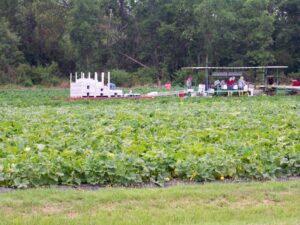
Typical harvesting methods in a squash field. This was the way the cucumber fields were picked on a commercial basis.
Financial Analysis
Planting and harvesting cost between the two fields were basically the same except for the variable cost of honey bees and bumble bees. Hence, the financial analysis focuses on the variable bee cost with respect to the yield. Yield data for one to 1.5 honey bee colonies per acre from previous years was not available.
There are on average one to three cucumbers per pound. These cucumbers are the large slicer cucumbers which average 1-2 cucumbers per pound. For this analysis, we chose a figure of 2.0 cucumbers per pound.
While there was not a statistically significant difference in yields between the two fields (at the ?=0.05 level), there was a numerical difference. The honey bee field yielded about twice the yield of the bumble bee field. This is about ( (68.07+82.01+21.61) pounds/(33.36+47.80+5.19)pounds * $0.67 /cucumber * 100% = 198.83% $/cucumber ) more cucumber crop dollars for the honey bee field over the bumble bee field at the current price ( July 1, 2011) of $0.67/average cucumber retail. It should be noted that unaccounted differences in soil and field location may account for part of this yield difference.
Honey bee field
206.85 pounds * (2 cucumbers / pound) * $0.67 average retail price 7/1/2011 per cucumber = $ 275.80 for four 10 foot plots
Cost of honey bees: 6 colonies * $50/colony = $300
Yield for entire honey bee field / cost of pollination for honey bees = insufficient data to determine
Bumble bee field
102.71 * (2 cucumbers / pound) * $0.67 average retail price 7/1/2011 per cucumber = $ 136.95 for four 10 foot plots.
For four bumble bee colonies:
Cost is $250/4 colonies, fob Detroit + $ 120 S&H = $370.
Yield for entire bumble bee field / cost of pollination for bumble bees = insufficient data to determine.
Objectives/Performance Targets
This research will assess the value of bumble bees (Bombus impatiens), in addition to honey bees, for pollination of cucumbers in the Lexington, SC area. We will be comparing fields pollinated with introduced honey bee colonies to fields with introduced bumble bee colonies. We know that in both cases there will be pollination from extraneous pollinators that we did not introduce, but we assume that it will be either negligible or equal and our differences will come from differential pollination efficiencies of our introduced pollinators.
(1) Mader, Spivak, Evans, “ Managing Alternative Pollinators, A Handbook for Beekeepers, Growers, and Conservationists,” SARE / NARES, February, 2010 ISBN 978-1-933395-20-3
It is proposed that one 2-5 acre field be pollinated with three honey bee colonies per acre (approximately 20,000 – 30,000 honey bees per colony), and one 2-5 acre field be pollinated by four bumble bee colonies per hectare (one hectare = 2.4711 acres). The yields from the two fields will be assessed to determine the difference between honey bee pollination and bumble bee pollination. Previously, 1.5 honey bee colonies were utilized rather than three honey bee colonies. Recent reports indicate the production value of 3 honey bee colonies per acre rather than one. (http://www.extento.hawaii.edu/kbase/reports/cucumber_prod.htm). The same cucumber variety will be planted within days of each other in the early May time frame, in anticipation of pollination and picking the end of May to first part of June. We will be assessing the use of bumble bees as compared to honey bees, and a doubling of honey bee colonies.
Objectives/Performance TargetsCucumbers: Honey bee hives and bumble bee colonies will be moved into the field when there is 15-20% bloom (2). Pollination will continue for about a week prior to harvesting. Flowers pollinated less than two hours prior to overhead irrigation fail to produce fruit if water enters the corolla. In addition, it will be determined the length of time that a bumble bee nest is strong enough to provide adequate pollination services, i.e. how many crops. Bombus impatiens recommendations indicate they should last approximately 8 weeks.
In 2- 5 acre fields (this is the minimum size field that is economically viable due to the size of the farmer’s equipment):
Honey bee colonies containing 20,000-30,000 bees will be placed in groups of four colonies around the edges of the field in quantities of 3 colonies per acre rather than the historic 1.5 colonies per acre.
Bumble bees will be placed in cool, shaded locations around field #2 at a density of 4 bumble bee colonies per 2.5 acres. The two fields will be located approximately 2-3 miles apart. Three subplots of similar size will be established in each of the fields.
The bee visits and yields from the subplots in each field will be recorded. One person will be hired to count the honey bee visits and bumble bee visits for each field, for a total of two people for two fields over the crop blooming period. Ten flowers will be watched for 10 minutes and the number of honey bees and bumble bees visiting the blooms will be counted. This will be repeated with different flowers for a total of 30 minutes of counting per field. Thirty minutes of counting will occur each day for one week after the honey bees and bumble bees are moved into the field. The following table will be consulted (2) to determine adequate bloom bee visits for cucumbers ( this table was generated in Michigan and may be different for the Lexington, SC area, i.e. bees typically do not visit booms in the middle of the day due to the heat but they still need approximately 10-15 bee visits per bloom per day) :
Time of count Min # bees/30 flowers/30 minutes
8:00-9:00 1
9:00-10:00 3
10:00-11:00 9
11:00-12:00 13
12:00-1:00 16
1:00-2:00 13
2:00-3:00 11
3:00-4:00 7
4:00-5:00 5
The cucumbers from each plot will be counted, weighed, and graded based on current grading standards. A comparison of the mean yields and their variances from the two fields will be conducted. Based on the statistical analysis, a financial analysis looking at the yields with respect to the variable cost will be conducted to determine the payback for just honey bees, and just bumble bees.
(2) Joe M. Graham, “ The Hive and the Honey Bee,’ 1992, ISBN 0-915698-09-9, pp 1060-1062
Accomplishments/Milestones
The results were presented at the Midstate SC Beekeepers Association Meeting on August 2, 2011 and also at the Wateree SC Beekeepers Association on September 1, 2011. The results will also be presented at the South Carolina State Beekeepers Association meeing in March, 2012.
Collaborators:
President
Rawl Farms
747 Calks Ferry Road
Lexington, SC 29072
Office Phone: 8033594415
Extension Associate - Vegetable Crops and Small Fruits
Clemson Extension
605 W. Main St. Ste. 109
Lexington, SC 29072
Office Phone: 8033598515
